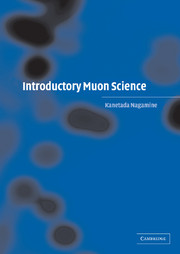Book contents
- Frontmatter
- Contents
- Preface
- List of abbreviations
- 1 What are muons? What is muon science?
- 2 Muon sources
- 3 Muons inside condensed matter
- 4 The muonic atom and its formation in matter
- 5 Muon catalyzed fusion
- 6 Muon spin rotation/relaxation/resonance: basic principles
- 7 Muon spin rotation/relaxation/resonance: probing microscopic magnetic properties
- 8 Muon spin rotation/relaxation/resonance: probing induced microscopic systems in condensed matter
- 9 Cosmic-ray muon probe for internal structure of geophysical-scale materials
- 10 Future trends in muon science
- Further reading
- Index
- References
2 - Muon sources
Published online by Cambridge University Press: 22 October 2009
- Frontmatter
- Contents
- Preface
- List of abbreviations
- 1 What are muons? What is muon science?
- 2 Muon sources
- 3 Muons inside condensed matter
- 4 The muonic atom and its formation in matter
- 5 Muon catalyzed fusion
- 6 Muon spin rotation/relaxation/resonance: basic principles
- 7 Muon spin rotation/relaxation/resonance: probing microscopic magnetic properties
- 8 Muon spin rotation/relaxation/resonance: probing induced microscopic systems in condensed matter
- 9 Cosmic-ray muon probe for internal structure of geophysical-scale materials
- 10 Future trends in muon science
- Further reading
- Index
- References
Summary
Experimental studies in muon science can only be conducted when a reasonably intense muon beam of high quality is available. As described in Chapter 1, muons from various sources, including both accelerator-produced particles and those of cosmic-ray origin, are compared in terms of energy and intensity in Figure 1.7. It is easily seen that at very high energy (higher than 100 GeV), cosmic-ray muons are the only possibility, whereas at low energy accelerator-producing muons are almost exclusively used.
In this chapter, more detailed information is given on the types of muon that can be obtained using present production strategies. It should be understood, however, that future developments in both accelerator technology and in ideas for muon beam production are quite likely to change the situation drastically.
MeV accelerator muons
Muons can only be obtained through the decay of the pions which are produced in nuclear interactions between accelerated particles and nuclear targets. These days, the high-intensity proton accelerator is the most popular source of accelerated particles. Figure 2.1 gives a list of medium-energy proton accelerators currently in use for muon physics research. These days, most activities are based on the accelerators of the so-called meson factories such as the Tri-University Meson Facility (TRIUMF) and Paul Scherrer Institute (PSI) which have beams with an intensity of some 100 μA to mA. From the viewpoint of time structure of accelerators there are two types: continuous and pulsed.
- Type
- Chapter
- Information
- Introductory Muon Science , pp. 17 - 39Publisher: Cambridge University PressPrint publication year: 2003



